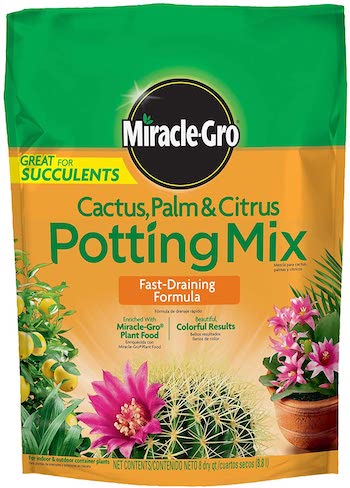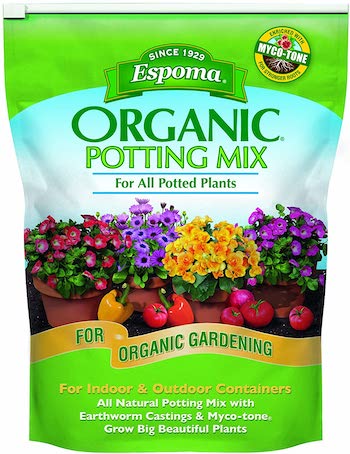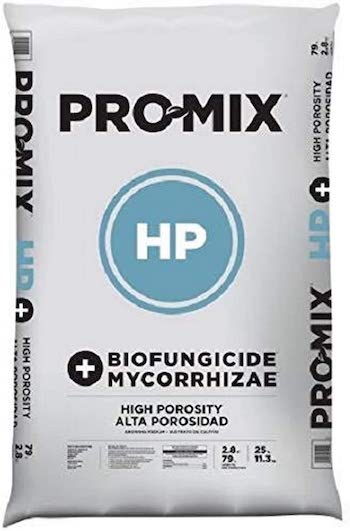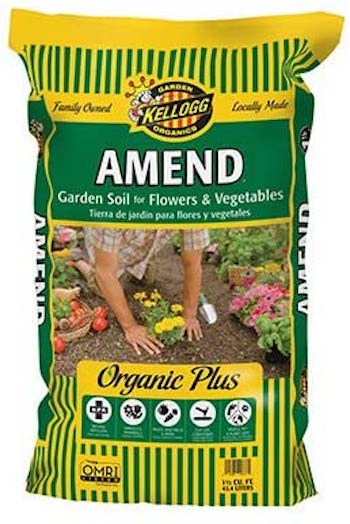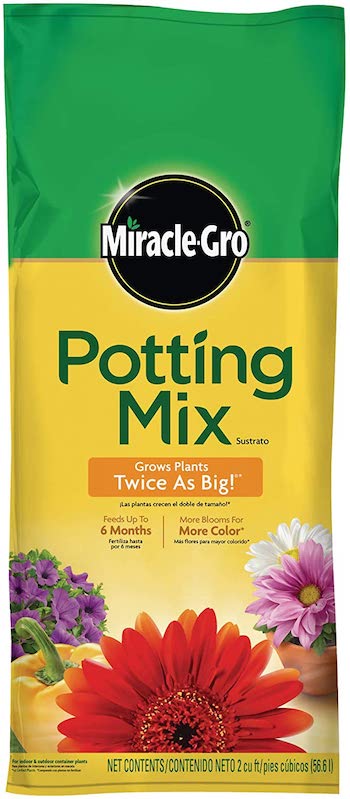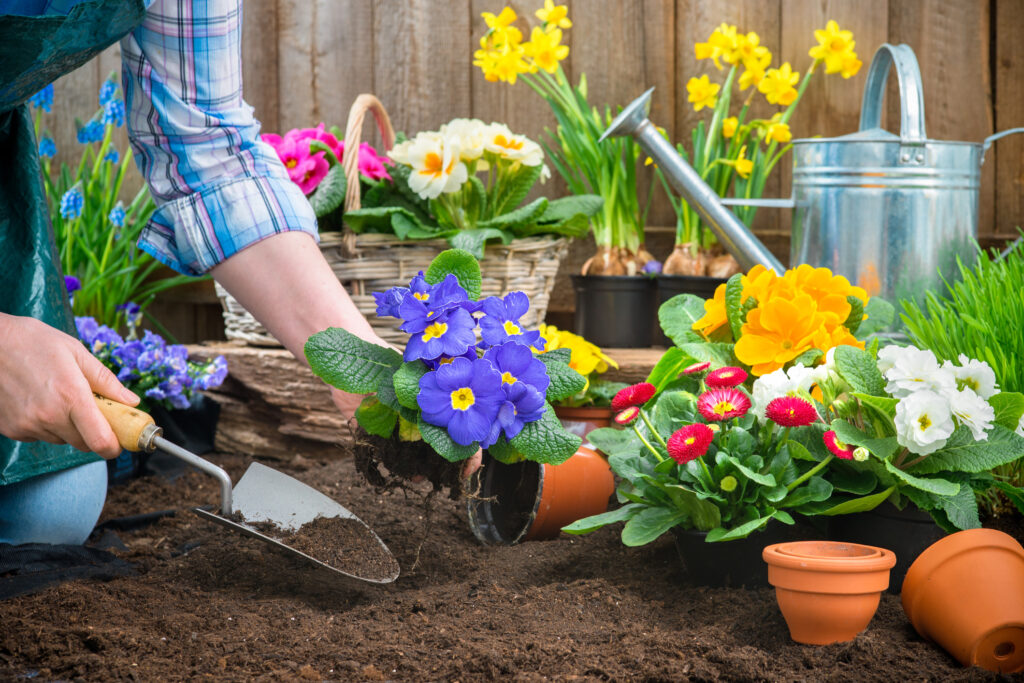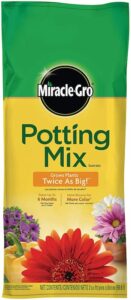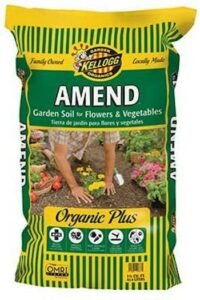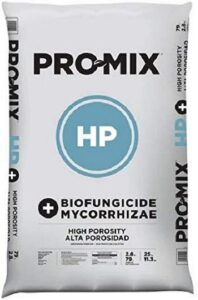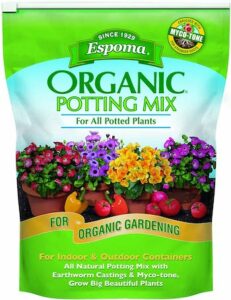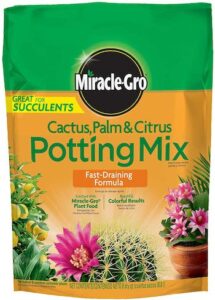5 Best Potting Soil Brands: How To Choose The Right Mix For Your Garden
If you’re an avid gardener like we are, then we’d be willing to bet that you’re feeling just as excited about the arrival of the gardening season. Of course, there are types of gardening that you can do outside of spring and summer but, where we live, this is truly the annual primetime when it comes to potting new plants and creating new vegetable gardens. We were pretty pleased with the results we got last year, but this year we’re planning on increasing the amount of actual potting we’ll do, specifically, as opposed to just planting our usual in-ground garden beds and raised garden boxes. We want to increase the amount of freestanding greenery that decorates our porch and patio, and we might even move a few things inside as well.
This means that we’ll need to purchase a kind of gardening earth that works equally well in the groundand in a planter, box raised bed or pot. After all, when there are as many fantastic kinds of multi-use potting soil out there as we’ve begun learning about, it’s not necessarily cost-effective to buy all different kinds of earth and soil if you can just get a larger quantity of one for ease, consistency, and a better price. We’ve been spending some time investigating the best potting soil options available online, with the logic that purchasing on the Internet affords us the time to really check out the details and consider the best options.
We’ve been gathering the links to the most effective, useful, and diverse potting soils we could find not only to keep track of them ourselves while we decide but also in hopes that what we come up with might help other fellow gardeners around us. At the same time, as we’re considering specific brand details, we’ve also been trying to learn more about potting soil in general, just to further ensure that we really know what we’re reading in researching each brand.
What is potting soil?
Potting soil is a type of custom-mixed soil that’s specifically designed to help plants germinate, take root, and thrive in any kind of container. Whether you’re mixing potting soil into your garden bed earth to add nutrients, filling variously sized planters with it for your balcony or bedroom, or topping up a window box to line your house with flowers, potting soil will keep the plants and their roots healthy and growing.
Potting soils, potting mix, topsoil, and gardening soil: What’s the difference?
For the most part, the difference between these different types of soil is in the primary base ingredient. Understanding more aboutall of these different types of soil is important so that you can choose the one that’s best for your desired conditions or, if you already know you need potting soil specifically, you can at least have a better grasp ofwhy.
- Inpotting soil, the main ingredient is very simple: it’s dirt! It is different, however, from plain earth taken right out of the ground. Potting soil has a mixture of extra things that are beneficial to your plants in order to help them thrive. We’ll cover this in better detail in the section below. You’d use potting soil to revitalize your garden beds or fill larger planting containers, like raised garden beds or large window boxes.
- Potting mix, on the other hand, isn’t actually primarily comprised of dirt or earth. It’s more like an extra “booster pack” that you might add to another kind of soilor fill a small container with, depending on what you’re planting. Potting mix is most often made from some combination of perlite, coir, peat moss, and pine bark. You can mix it with earth for larger planting boxes or fill a small container with it to give roots better moisture, nutrition, and air circulation than just dirt provides.
- Topsoil is the kind of natural earth or soil that you’d find in your yard where the grass has been cut away and the earth beneath has been exposed so that other things can be planted. There are different kinds of topsoil, depending on where you live, and some are better than others for growing different kinds of plants. Places with topsoil layers that naturally have lots of clay, silt, or sand, for example, are not ideal for gardening, as these aren’t conducive to thriving roots because they don’t hold nutrients well and they cut off the air supply. You would not use top soils for container gardening, and most topsoils (even the good ones that don’t contain what we listed above) still need to be mixed with some kind of fertilizer to be gardened.
- Garden soil is a term used to describe the earth in your garden beds that have been previously planted. It likely didn’t originally contain all of the ideal nutrients, fertilizers, and so on that are ideal for growth, but it will contain beneficial bits and pieces left from previous plants, previous mixtures and additives, and so on. It’s not likely that even previously used gardening soil that yielded good results will give you the best garden all on its own, but good quality gardening soiland be mixed with potting soil for a better, more beneficial combination that you can plant almost anything in with success.
What makes the best potting soil?
By now, you can probably recognize that potting soil is not just your average yard dirt. Potting soil is a mixture of natural ingredients that work together to give the plants and their roots the perfect conditions in which to thrive, creating balance between all the elements. The best potting soils usually contain:
- Compost
- Peat moss
- Vermiculite
- Pine bark
- Perlite
- Coir fiber
Some store-bought potting soils might contain a few other nutrient-rich ingredients or fertilizing elements, depending on the brand, but those are often what’s found mixed into the base material. Good potting soil is lightweight and not too dense, which is great for water absorption and nutrient holding. The texture is almost “fluffy” in nature, which allows good air circulation throughout the garden bed or pot since roots actually do need air despite being buried. In fact, the absolute most important elements to consider in potting soil are:
- Weight (should be lightweight and not super dense or compact)
- Airflow (mix should appear “fluffy” to the touch)
- Texture (ideal potting soil has a texture that’s quite smooth and looks uniformly mixed)
- Moisture (should be able to hold moisture well without getting dry or mucky too quickly)
- Nutrients (the best potting soil is full of things that provide the roots with potassium, phosphorus, and nitrogen)
Best Potting Soil
If you’re still in need of some assistance when it comes to teasing out the perks and drawbacks of specific brands of potting soil, check out the list below. We created a useful pros and cons style outline for the five best mixes and brands that we came across in our own search and feeling pretty good about recommending them to you.
1. Miracle-Gro potting mix
If you’re looking for an extremely accessible brand of potting soil that will work for you as an expert but also for your kids’ first herb garden as beginners, thenMiracle-Gro has just what you need. In fact, we’d list it as our top pick! It’s suitable forall kinds of planting, including vegetables, shrubs, flowers, herbs, and trees, and it helps plants thrive both indoorsand outdoors. It’s also just as useful for container gardening as it is for mixing into an in-ground flower bed. This potting soil contains a slow-release fertilizer that’s guaranteed to provide nutrients to the roots of your plants for up to about six months.
Because it helps build such perfect soil conditions for your plants and their roots, this soil actually also builds perfect conditions for some kinds of bugs. This isn’t inherently a bad thing, as a lot of the insects that will find this potting mix and the earth you combine it with appealing won’t actually harm the plants themselves. Some of them might even protect them from other pests thatwill try to eat them, but it’s worth noting so that you can keep track of what kinds of critters move in and whether or not your plants are, indeed, safe.
Pros:
- Top-notch base for indoor and outdoor gardening
- Good mixture and density for container plants (even small ones)
- Contains slow release fertilizer that keeps providing nutrients for about six months
- Great choice for all skill levels, from beginner to expert gardeners
- Suitable for vegetables, flowers, herbs, shrubs, and so on
Cons:
- Also creates perfect conditions for many kinds of bugs and insects to move in
2. Kellogg Supply Amend Mix
If you’re a very experienced gardener indeed and you’re looking to actually overhaul your soil quality for better outdoor planting, then this next product, which is literally and aptly called Amend and is sold by Kellogg Supply, might be your ideal choice. This soil is mixed specifically to “fix-up” and add to decent gardening soil, improving its growing conditions and making it even more ideal for growing vegetables and flowers. It features a nutrient-rich formula for strong root systems and durable growth, and it also improves airflow with its impressive texture, even underground level. It contains balanced ingredients for improving soil drainage, allowing the roots to access water quicker and more effectively, cause the plants to need watering less. It’s made of entirely natural ingredients and doesn’t contain any active elements, making it very pet-friendly.
Although this potting soil seems to have everything under the sun, it actually doesn’t contain any fertilizers. Itdoes build the perfect conditions for the roots to absorb nutrients more effectively, but the actual fertilizing elements themselves must be added separately and according to what you’re planting.
Pros:
- Specifically intended for adding to garden soil to fix it up and improve its quality for growing flowers and vegetables
- Excellent tool for professional-level gardeners who want to analyze and make good changes to plots and beds
- Nutrient-rich formula for stronger growth than other soils can provide
- Improves airflow, particularlyinside the ground
- Improves soil drainage, which gives more water to the roots quicker and therefore requires less watering overall
- Pet-friendly; doesn’t contain any active ingredients
Cons:
- Doesn’t contain any fertilizers in its mixture; these must be added separately (and according to what you’re planting)
3. Premier Horticulture HP Pro mix
If you’re looking for a useful all-purpose soil that’s especially great for beginners, thenPremier Horticulture might have you covered. This soil has a quick-drying peat-based formula that’s effective for water-sensitive plants and helps avoid overwatering. It’s also effective even in low-light conditions thanks to the absorption capabilities cause by Mycorrhizae inclusion. An active Biofungicide ingredient, on the other hand, protects roots from molds and funguses for longer than average. The soil stands up well against high humidity, can be used just as well indoors or outdoors, and will support all different garden types very well.
Although the basic properties of peat mossare a beneficial thing to the overall functions of potting mix, this particular brand is one that some people found to be a little heavy on it. This means that it can actually dry out a littletoo well or quickly for some plants, particularly if they’re potted. You’ll want to pay very careful attention during watering to make sure that enough is actually being absorbed by the plant and not just absorbed, drained out, and dried up by the peat moss-heavy soil before the plant has had a sufficient drink
Pros:
- Great for growing plants that are water-sensitive thanks to its peat-based formula quick-drying without losing nutrients
- Good soil for growing in low light conditions thanks to Mycorrhizae element
- Inclusion of Biofungicide gives roots extra protection for longer
- Well suited for conditions of high humidity
- Useful both indoors and outdoors, and on all garden types
- Particularly friendly for beginner gardeners
Cons:
- Heavier peat moss content than most brands means it can dry out a littletoo quickly and drain a littletoo well for some plants, even water-sensitive ones
4. Espoma 8 quart organic potting mix
If you’re looking for something diverse, quick, and easy but that will also contribute specifically to plant strength, you might get along well indeed with this potting mix fromEspoma. This potting mix is perfect for combing with soil that’s headed for garden beds, indoor pots, or outdoor planters because its properties are diverse enough for all different conditions. It was mixed with an advanced Myco-Tone water-saving formula that holds onto moisture without allowing overwatering, letting roots absorb it in their own time for maximum health. This feature also helps the soil get the plants through very hot days or drought periods outside. In terms of nutrients, the mixture contains earthworm castings to boost plant strength and size.
Most previous buyers have been quite thrilled with the actual effects and results of this potting mix itself, but several of them have warned others of one key point of concern. Because the mix holds water so well, it’simperative that you store whatever you don’t use right away properly and sealed airtight. If it becomes exposed toany moistureat all in the bag, it will hold onto it but have nowhere to drain it in the packaging, which will result in the ruin of your leftovers thanks to fungus or mold.
Pros:
- Specifically mixed for plant strength thanks to earthworm casings
- Diverse enough for indoor or outdoor conditions, and beds or containers
- Myco-Tone water saving formula holds onto moisture well and enables slow root absorption without overwatering
- Good for places that experience drought periods in the summer
Cons:
- High water absorption capabilities mean that mixed leftovers must be stored absolutely airtight; exposure to absolutely any moisture will cause fungus growth or molding and therefore ruin
5. Miracle-Gro cactus, palms, & citrus mix
Just in case you’ve been holding out for something a little more specialized towards your succulents and similar plants, here’s a custom-made option from Miracle-Gro that will help them thrive. This potting mix is designed to be a fast-draining formula that hydrates durable plants like cacti, palms, and succulents just enough but without over-saturating them, which they certainly don’t need. The inclusion of the brand’s patented Miracle Gro Plant Food as nutritional fertilizer is geared towards fostering beautiful color in a natural way. The mixture is customized from their usual potting soil mixture to be a little heavier on the sand and perlite, amping up the drainage a tiny bit extra to help avoid soil compaction, which is something these kinds of plants, in particular, would struggle to thrive in.
This mixture might be something that you can mix with soil, but the more it’s mixed with, the less effectively it can benefit your plants. This is why it’s primarily recommended just for container planting and in smaller sizes rather than for more diverse and wider-scale gardening. It’s great for planting little indoor cacti and succulents that are more decorative. Additionally, this is another mixture that you’ll want to be sure to store absolutely airtight if you have leftovers. The particular conditions created by the soil in the plastic bag really appeal to various types of flies, who will take the first chance to nest in it if it’s not sealed properly.
Pros:
- Great for small scale indoor planting
- Ideal for succulents, cacti, palms, and other moisture-sensitive plants
- Specifically mixed for a little extra drainage in order to avoid over-saturating
- Inclusion of Miracle Go Plant Food encourages beautiful, bright natural colors
Cons:
- Not suitable for planting on a large scale or outside, as its effectiveness is reduced with lots of soil mixing
- Must be stored properly and sealed airtight, or flies will be attracted by the conditions created by leftovers in the bag and nest in it, effectively ruining it and hassling you with bugs
Mixing your own potting soil for your garden
Believe it or not, making your own potting soil isn’t actually that difficult! Most people who make their own, however, still often purchase some kind of nutrient-rich potting mix or a small quantity of potting soil to mix into their own custom planting earth. If you’re an avid composter who has been doing it for a while and has a fantastic, well-rotted composting base to draw from then, you might be able to get away with no purchased potting soil, but there’s most often a combination of the two used, depending on the soil type and whether you can even use any of the garden soil your yard already provides. People who have gardened for years and have built a good base of organic plant material will have a better resource in their garden beds for mixing than others.
To mix your own potting soil, you should:
- Make sure that your base dirt (ex. your gardening soil, if yours is suitable) is free of natural pollutants like weeds, molds, and plant-eating bugs or pests.
- Mix in compost (preferably well-rotted or fermented), as well as common ingredients found in the average potting soil, like perlite and/or peat moss.
- If your base soil is not a grain-filled type, like sandy soils, consider also mixing in a small amount of gravel textured elements for air circulation and draining, just to make sure your finished product isn’t too dense. You might use dolomite limestone, kelp powder, soybean meal, or any combination of those things together, depending on your soil’s base density.
- Add water to get the mixture moist and allow the elements to adhere together and begin absorption, using a shovel to mix the concoction thoroughly.
- Press your new mixture through a soil filter to break up clumps and get rid of large particles that could cause problems later.
- Spread the soil in a pan or on a tarp and let it dry in the sunlight.
- Pot with it right away or store it in a sealed plastic bag for later to keep it fresh and safe from either drying out too faror degrading from taking on too much moisture
Improving your soil
Just in case you’ve been scrolling through our information, hoping to learn more about using soil in general, rather than only which potting soils are best, here’s another useful discussion for you. We’ve already mentioned that you likely have one of a few types of topsoil in your garden beds and that it’s rare for natural topsoil to be already ideal and fully prepared without having something mixed into it. In addition to mixing things like potting soil in with your top and gardening soils in your garden beds, however, there are also scenarios where you might be able to actually improve the topsoil you’re working with for additional gardening success.
By adding very specific things according to what your soil lacks or needs to have balanced out, you can create a better default environment for the plants you’re adding to that garden bed or plot. This will only help the potting soil (and whatever other additives or fertilizers your planned seeds need) along the way when it comes to things like air circulation, correct moisture, and nutrient content. Check out this topsoil guide and what we’d recommend adding for improvement:
- Chalk soil: This soil is usually recognizable by how pale it is. This chalky appearance comes from the presence of flint and/or limestone fragments in the earth in that area. Chalk soils warm up very quickly, rather early in the seasons, and they often lie over a solid bedrock deeper down. This and the fact that the soil is full of fragments makes chalk soil difficult to dig through. It also makes the soil free-draining. To improve chalk soil, you can:
- Mix in potting soil, potting mixture, or organic material, like homemade compost; this helps even out how quickly the water drains, stops drainage from carrying the moisture away, and adds lacking nutrients.
- Loam soil: Overall, loam soil actuallycan hold nutrients better than some other kinds, and it’s a little more balanced within its own properties, even though it’s still not ideal. Loam soil is filled with both clay particles and sand particles, and these are what provide it a measure of balance. While the clay retainssome moisture and nutrients, the sand grains improve drainage a touch. Loam soils, which warm slowly, are known for having a healthy worm population, and this can act as a sort of natural fertilizer for plants, but it can usually still use a boost. To improve loam soil, you can:
- Mix in some kind of fertilizer (yes, people absolutely still use mixtures made with animal manures because they’re nutrient-rich), potting soil, or potting mix; because this soil is already decently well balanced but just slightly lacking in the ideal nutrients and textures, a simple mixing job will help enrich it just also improve air circulation.
- Clay soil: Although they’re still considered a “problem soil” overall when they’re left as-is, clay soils are actually also the most naturally fertile for gardening. This is all thanks to the ability of the clay particles within the earth to absorb and hold onto good nutrients. The clay only holds moisture for a short amount of time, though. This is useful for digging since it’s nice and easy to break up clay soil when it’s dried out, but it’s not the best for most plants. To improve clay soil, you can:
- Add extra organic materials like compost to bulk up the texture and improve nutrient hold.
- Add a small amount of gravel to break up the dense clay and improve drainage.
- Sandy soil: Just like a sandy beach, this kind of soil is made up, of course, grains, which means it lacks organic matter since, at a microscopic level, those grains are all tiny bits of stone. Sandy soils drain well since water can easily trickle between the grains, and they can be planted quite early because they warm quickly in the season. In many places, sandy soils can actually be cultivated all year, but they don’t absorb enough nutrients to support much more than the hardiest of plants. Succulents, for example, do very well in sandy soils where plants that need richer, more moist soils won’t thrive. To improve sandy soil, you can:
- Add compost, but preferably a batch that is particularly well-rotted for extra nutrient-rich hold; sandy soils drain so freely that anything in them that might have fertilized the plants rushes downwards and away from their roots, and well-rotted compost can replenish this and add a texture that holds moisture a little more effectively.
If you know someone else who could use a little more guidance when it comes to choosing the right potting soil that’s really the best choice for their needs, share this post with them so they have a little more information to work with.
